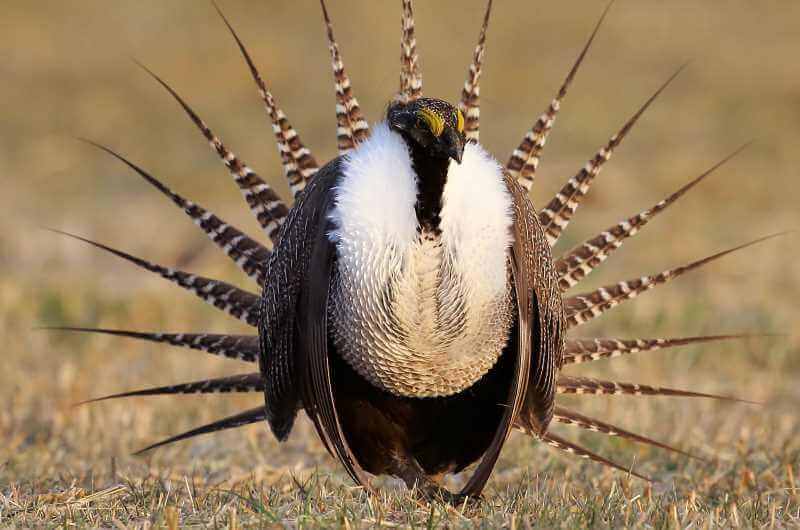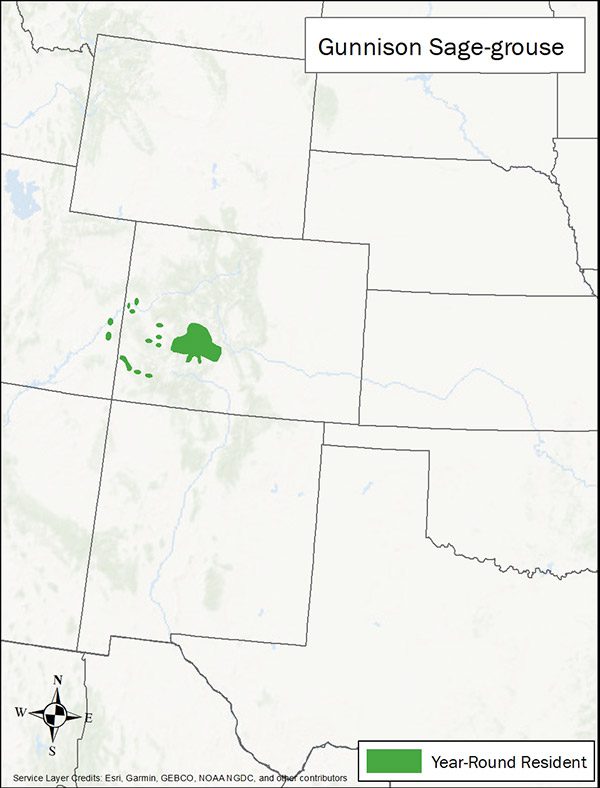LandPKS Learning
Habitat Hub

Gunnison Sage-grouse
Gunnison sage-grouse became officially recognized as a distinct species from greater sage-grouse in 2000, and was the first new bird species recognized in the U.S. since the 1800s! They are geographically isolated from greater sage-grouse populations, found in seven distinct populations in southwestern Colorado and southeastern Utah. There are fewer than 5,000 individual Gunnison sage-grouse, and the species is classified as Threatened under the Endangered Species Act.
Centrocercus minimus
Identification
The Gunnison sage-grouse is smaller than the greater sage-grouse (2-5 lb/1-2.4 kg) and looks similar with a few exceptions: Gunnison sage-grouse males have longer, thicker feather plumes extending on the back of the neck (called filoplumes), and they have shorter, more distinctly banded tail feathers. Adult males are mostly brown with mottling on the back and wings, a pointed tail, a black belly, a white breast, and two yellow air sacs that inflate during the breeding display. Females are more cryptic and lack the conspicuous white breast, air sacs, and neck feathers.
Observation Tips
Gunnison sage-grouse have a breeding display March-May where males gather on leks (i.e., breeding grounds) in the early morning to attract females. Leks are usually located in basins, on ridges, and in other open areas. Males strut with tails fanned, popping their inflated air sacs, and fighting each other for a chance to mate with the females. In the winter, they gather in large flocks, although the birds tend to segregate by sex throughout the year. Gunnison sage-grouse resides year-round, and may make seasonal movements between habitats used for breeding, nesting, and over-winter.
Interesting Fact
Gunnison sage-grouse became officially recognized as a distinct species from greater sage-grouse in 2000, and was the first new bird species recognized in the U.S. since the 1800s! They are geographically isolated from greater sage-grouse populations, found in seven distinct populations in southwestern Colorado and southeastern Utah. There are fewer than 5,000 individual Gunnison sage-grouse, and the species is classified as Threatened under the Endangered Species Act.
Ideal Habitat
Gunnison sage-grouse use a variety of habitats during the year, mainly sagebrush shrublands, but also wet meadows, irrigated pastures, alfalfa fields, and greasewood bottoms when hens are raising chicks. They also use sagebrush adjacent to pinyon-juniper and aspen stands and mountain shrub communities composed of sagebrush, Gambel oak, serviceberry, and snowberry. They nest on the ground, usually under a sagebrush shrub, in areas of 10–25% sagebrush canopy cover that are 10-20 in/25–50 cm tall, with 10–40% perennial grass cover that is 4-6 in/10-15 cm tall, and 5–40% forb cover. They winter in areas with >25% sagebrush canopy cover with shrubs that are >16 in/40 cm tall, often on south and west-facing slopes and ridgetops. In summer, they eat mostly insects and also sagebrush shoots, buds, and flowers. In winter, they eat sagebrush leaves almost exclusively.

Range map provided by BirdLife International
Management Activities that Benefit Species – Best Management Practices (BMPs)
Maintain a large mosaic of tall sagebrush mixed with native grasses (including perennial bunchgrasses), forbs, and legumes—control invasive plants, such as cheatgrass and encroaching trees. Rotational grazing can maximize the amount of time substantial grass cover is present within pastures. Mark fences with markers to prevent sage-grouse collisions. Restore degraded streams or meadows by installing simple rock dams to reduce erosion and help retain soil moisture. These restored wet meadows especially benefit sage-grouse hens and chicks. Minimize habitat fragmentation and other disturbances in areas where sage-grouse breed.
If large stock tanks are used for livestock, wildlife escape ladders can provide an escape route. Minimize disruption to breeding by adjusting the timing of energy-related activities. Energy-related infrastructure should be located >2 mi/3.2 km from leks, whenever possible. Human activities within 0.3 mi/0.5 km from leks should be minimized during the early morning and late evening when birds are near or on leks.
Management Activities to Avoid
Avoid heavy grazing, extensive herbicide application, large mechanical sagebrush removal treatments, and prescribed fire, which reduce shrub canopy cover and degrade habitat. Avoid grazing wet meadows and riparian areas in late summer to reduce impacts on shrubs and forbs. Avoid the use of insecticides in sage-grouse habitat, which can reduce insects that sage-grouse eat in the summer.
Other Species that Benefit from Similar Habitat Management
Management for Gunnison sage-grouse will benefit other sagebrush species including sage thrasher, Brewer’s sparrow, green-tailed towhee, and mule deer.
Download
Download the Gunnison Sage-Grouse factsheet
Other Resources
BirdLife International and Handbook of the Birds of the World. 2019. Bird species distribution maps of the world. Version 2019.1. Gunnison sage-grouse
The Cornell Lab of Ornithology. All About Birds Gunnison sage-grouse
Bird Conservancy of the Rockies. 2015. Integrating birds into sagebrush management. Brighton, CO. 89 pp.
Gunnison Sage-grouse Rangewide Steering Committee. 2005. Gunnison Sage-grouse rangewide conservation plan. Colorado Division of Wildlife, Denver.
Consult with your state wildlife agency about grouse population management.
Mobile App | Data Portal | Knowledge Hub | Habitat Hub | Learning Collections | Blog | About | Contact | Support



